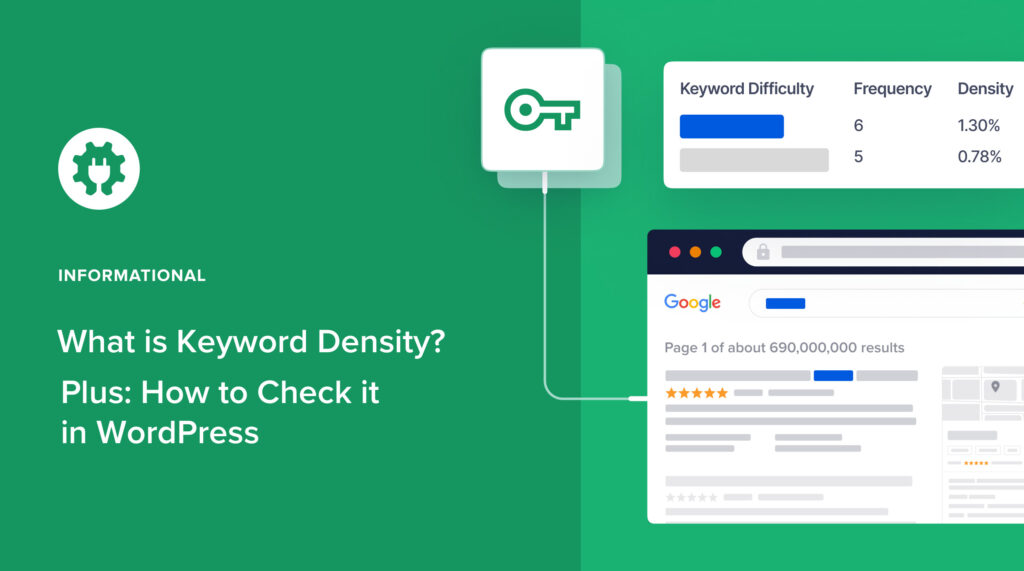Is keyword density important for SEO? If so, how can you measure it in WordPress?
In this article, we’ll explain keyword density and why industry thinkers disagree on its role in SEO.
In addition, you’ll discover an automated way to check the keyword density of your WordPress articles.
Let’s start with a definition.
In This Article
What is Keyword Density?
Keyword density is an automated measure of the frequency of a specified keyword on a single web page.
Calculating keyword density: This metric, typically expressed as a percentage, is calculated by dividing the keyword’s frequency by the total number of words on that page.
For instance, if a keyword appears 10 times in a 2,000-word article, we would divide 10 by 2,000 and multiply by 100. The resulting keyword density would be 0.55%.
What are Keyword Density Checkers?
Few people have the time or inclination to calculate keyword density manually. And thanks to software, there’s no need to.
WordPress SEO plugins, like All in One SEO (AIOSEO), include keyword density checkers.
These checkers display the percentage metric and recommendations based on a target density.
In the example below, AIOSEO was used to check keyword density on 2 pages. The first page returned a low-density score and a recommendation to add more instances of the keyword.
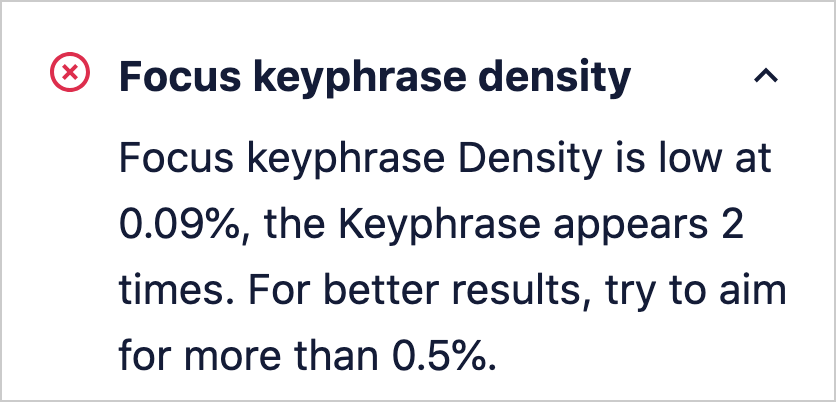
This second example shows the page passed the keyword density check, which aims for a frequency of 0.5% or higher.

Is It Keyword Stuffing?
Keyword stuffing is the old black hat SEO tactic of cramming a page full of repeated keywords in the hopes of ranking higher.
Pages like this make for awkward reads. And Google penalizes keyword stuffing.
The goal of keyword density targets is different: they serve as a proxy for keeping your content focused on your main topic.
And the density target is far lower than what you’d find on keyword-stuffed pages. In fact, keyword density checkers can be used to detect keyword stuffing.
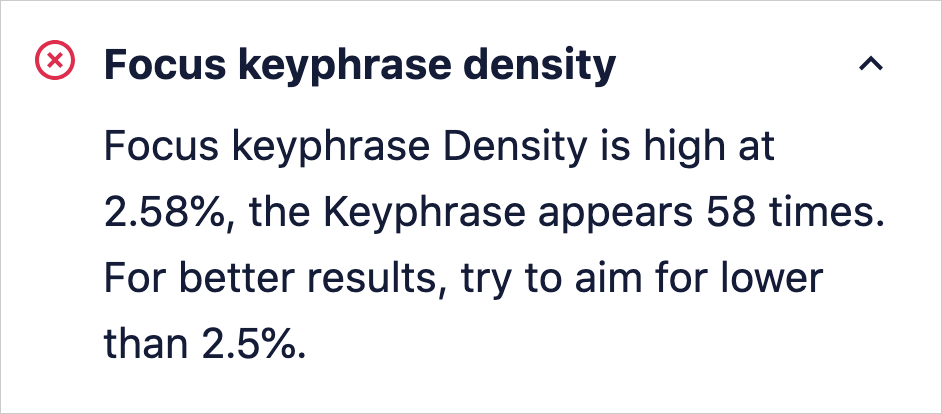
That said, does keyword density impact SEO?
Does Keyword Density Matter for SEO?
Here’s where we run into differing opinions.
SEJ, Ahrefs: Keyword Density Doesn’t Matter
Search Engine Journal asserts that “using keywords is important, but hitting a certain ratio won’t help your SEO efforts.”
The article notes that Google doesn’t specify any ideal keyword density, and there’s no evidence it’s a ranking factor. After all, anything that can be easily gamed is unlikely ever to be a ranking factor.
And you can indeed find pages that rank for a keyword that doesn’t appear on that page. For example, this Kinsta article on submitting websites to search engines ranks #1 for the keyword “submit site to search engines.” That keyword appears in the URL but nowhere else on the page.
Likewise, Ahrefs emphasizes that Google has other ways of assessing how well a page matches search intent. For instance, Google can recognize keyword variants (related terms).
Ahrefs also quotes some of Google’s experts, including John Mueller, who said, “And keyword density, in general, isn’t something that I would focus on . . . search engines have kind of moved on from there over the years, as well.”
“Keyword density isn’t important for SEO,” Ahrefs concludes.
Authority Hacker: Keyword Density Does Matter
By contrast, a recent study by Authority Hacker found that keyword density matters.
The study analyzed over 1 million search results to understand better how Google ranks content.

Authority Hackers is known for generating exponential growth in website traffic and revenue. They’ve done it many times themselves, and they teach others their strategies.
So, what did Authority Hackers find?
- “Keyword density” and the “number of keywords in the content” correlate with higher rankings.
- Longer content correlates to higher rankings not because of length per se but because the length allows “room for more keywords to be inserted at a non-spammy density.”
It’s worth reading the study to get the nuanced conclusions that Authority Hacker arrives at.
If you want to check keyword density, either to hit a target ratio or to avoid keyword stuffing, follow the simple instructions below.
How to Check Keyword Density in WordPress
We recommend using All in One SEO (AIOSEO) to check keyword density.
All in One SEO (AIOSEO) is an established plugin with thousands of 5-star reviews on WordPress.org. Currently, it’s used by over 3 million site owners.

This beginner-friendly plugin makes it easy to optimize your pages for SEO. Keyword density is one of many factors that AIOSEO checks.
Step 1: Download and Install All in One SEO (AIOSEO)
After you download and install AIOSEO, a setup wizard will walk you through a few steps.
Step 2: Enter Your Focus Keyword
While still logged into WordPress, navigate to a page you want to check keyword density on.
Click the AIOSEO button at upper right to open the AIOSEO sidebar.
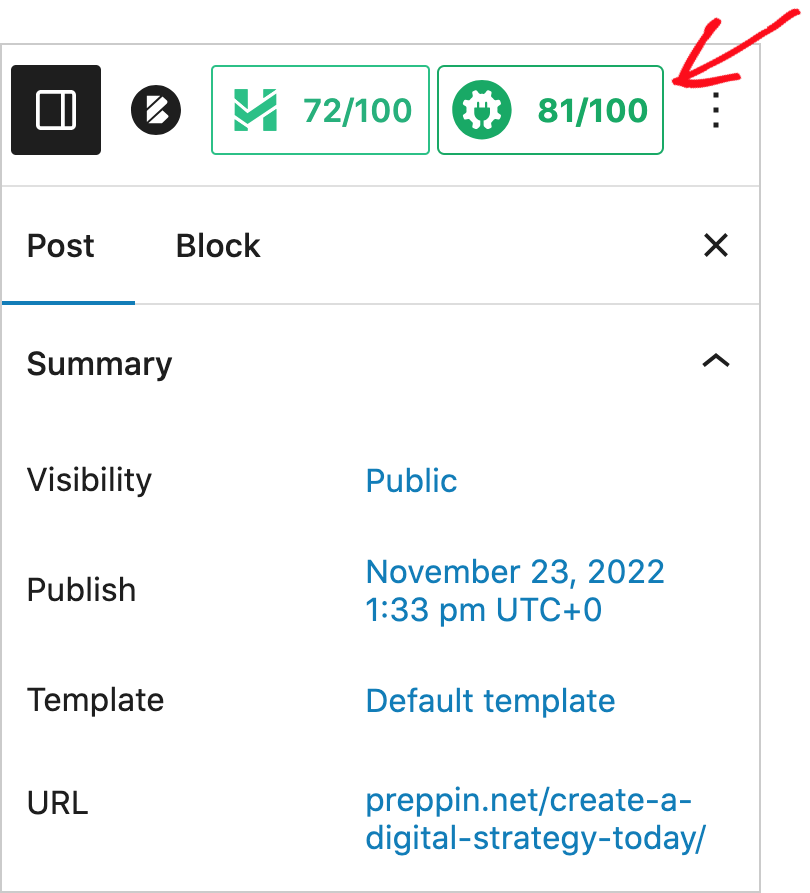
Next, click General.

Now, you’ll see several tabs, including Focus Keyphrase and Basic SEO.
Click on Focus Keyphrase.

In the empty field, enter the target keyword for your web page. Then click the Add Focus Keyphrase button.

Focus keyphrase, keyword phrase, focus keyword, and target keyword are all synonyms.
Now, AIOSEO will analyze your page for focus keyphrase use.
Specifically, AIOSEO will look for the presence of your focus keyphrase in:
- Title and meta description
- URL
- 1st paragraph
- Some subheadings
- At least 1 image alt text
AIOSEO allows you to set an “SEO title” (which appears in search results) while displaying a different page title to site visitors. SEO title and title tag are often used synonymously.
You’ll see what you’re doing well.

And what could be improved.

Step 3: View Keyword Density
You’ll find keyword density at the bottom of the Focus Keyphrase checks.
If your keyword use doesn’t meet the target density, you’ll see a red x.
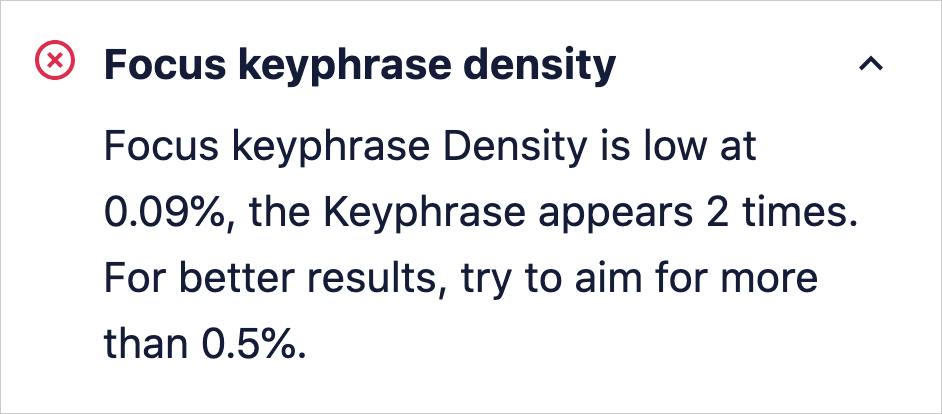
To act on the recommendation, add more instances of the keyword.
AIOSEO’s analysis will update in real-time.
Pro tip: Always keep the reader foremost. The use of a focus keyword should sound natural and not forced. Use your judgment if your web page is close to the target density, and adding more instances will make the text sound awkward.
Q&A Related to Keyword Use
What keyword density percentage indicates keyword stuffing?
There’s no set percentage that indicates keyword stuffing. Generally, anything at or higher than 2% may signal stuffing.
Often, an editor can detect keyword stuffing quickly because the repetition results in awkward prose.
Instead of seeking a hard and fast rule, always put the reader first.
What is a primary keyword?
A primary keyword is the main search term targeted on a web page. This is the keyword that you want the page to rank for.
Some writers target more than one keyword. In All in One SEO (AIOSEO), you can add more than one keyword for automatic analysis.
What’s the ideal word count for SEO?
There’s no ideal word count for SEO. That’s because Google doesn’t reward verbosity but usefulness and quality. To rank for a keyword, you must produce high-quality content that satisfies user intent.
Consider search intent first and then decide what subtopics you need to cover to satisfy users. These principles should come first rather than total word count.
Resources on Keywords and SEO Strategy
As you add to your SEO techniques, these resources will help you become more competitive as you boost your page rankings.
For example, in the first 2 articles, you’ll learn how to start with a specific keyword and find related keywords that are valuable and easy to rank for.
In Referring Domains vs. Backlinks, you’ll discover the explosive power of backlinks to drive traffic, revenue, and website valuations.
And, if you’re new to keyword research, check out the beginner’s guide below. This will explain how to discover the search queries that your target audience uses when searching for products and services you provide.
- How to Find Low-Competition Keywords that Drive Conversions (Includes long-tail keywords and search volume)
- Keyword Difficulty in SEO: What Is It and How to Use It (Includes Semrush tutorial)
- Referring Domains vs. Backlinks: What’s the Difference?
- How to Track Your Google Search Engine Rankings in WordPress
- SEO vs. Social Media: How Do Their Roles Differ in Digital Marketing?
- What are SERPs (Search Engine Results Pages)?
- Best On-Page SEO Tools
- Keyword Research for Beginners
- How to Use Social Proof to Improve User Experience
- How to Monitor the Impact of Google Algorithm Updates
Keyword Density Tools
Not using WordPress but want a keyword density checker?
Try one of these free options:
- Small SEO Tools Keyword Density Checker
- SEO Review Tools Keyword Density Checker
- WebConfs Keyword Density Checker
What to Learn Next?
You’ve learned what keyword density is and how the formulas work. And you know how to check keyword density in WordPress.
So, what’s next? Learn how to optimize your web page fully with AIOSEO. This tutorial will walk you through optimizing your SEO title, headings, and other page elements. And you’ll learn how to optimize for readability too.
And learn how to apply schema markup, which helps Google understand your page and rank it for relevant keywords.
To learn more about search engine optimization, subscribe to our YouTube Channel. Each week, we publish new step-by-step tutorials there.
And follow us on X (formerly Twitter), LinkedIn, or Facebook to stay in the loop.
Disclosure: Our content is reader-supported. This means if you click on some of our links, then we may earn a commission. We only recommend products that we believe will add value to our readers.
